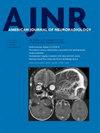Vestibular schwannoma-related increased labyrinthine post-gadolinium 3D-FLAIR signal intensity and association with hearing impairment.
IF 3.7
3区 医学
Q2 CLINICAL NEUROLOGY
引用次数: 0
Abstract
BACKGROUND AND PURPOSE Vestibular schwannomas (VSs) are benign neurogenic tumors commonly associated with progressive unilateral hearing loss, tinnitus, and vestibular symptoms. Growing evidence links signal changes in the VS-adjacent labyrinth with sensorineural hearing loss. This study seeks to quantify the association of labyrinthine signal on post-gadolinium 3D-FLAIR imaging correlates with hearing loss and to evaluate potential longitudinal changes over time. MATERIALS AND METHODS Selected patients were identified from a prospectively maintained VS registry. Mean signal intensity ratios of the bilateral labyrinth and pons were measured on 3D-FLAIR post-gadolinium MRI. Correlations with paired audiometric data including pure tone average (PTA), word recognition score (WRS), and AAO-HNS hearing class within one year were evaluated. RESULTS 125 studies obtained from 2015 to 2022 among 66 patients undergoing observational management for sporadic VS were analyzed. Increased signal intensity was noted of the VS-affected labyrinth/contralateral labyrinth (mean ratio 1.56, SD 0.58). Increased signal intensity was associated with increased PTA on both labyrinthine (correlation coefficient [CC] 0.20, p=0.03) and pontine comparisons (CC 0.24, p=0.006), and with decreased WRS on pontine comparisons (CC -0.18, p=0.04). Increased signal intensity was significantly associated with non-serviceable AAO-HNS C/D hearing when intensities were compared to the pons (p=0.01) but not the contralateral labyrinth (p=0.1). Among 44 patients with available follow-up, no statistically significant associations were identified between audiometric data and signal changes over the same interval. CONCLUSIONS Increased 3D-FLAIR post-gadolinium labyrinthine signal is associated with sensorineural hearing loss; however, its relationship with hearing trajectory remains unclear. Overall findings suggest that while post-gadolinium 3D-FLAIR techniques are sensitive to inner ear involvement associated with VS, the driving mechanism and their temporal relationships with labyrinthine signal intensity and hearing impairment remain unknown. ABBREVIATIONS AAO-HNS =American Academy of Otolaryngology -Head and Neck Surgery. BLB =blood-labyrinth barrier. CPA = cerebellopontine angle. IAC = internal auditory canal. PTA = pure tone average; SIR = signal intensity ratio. VS = vestibular schwannoma. WRS = word recognition score.前庭分裂瘤相关的迷宫钆后 3D-FLAIR 信号强度增高及与听力损伤的关系。
背景和目的前庭分裂瘤(VS)是一种良性神经源性肿瘤,通常与进行性单侧听力损失、耳鸣和前庭症状有关。越来越多的证据表明,VS 相邻迷宫的信号变化与感音神经性听力损失有关。本研究旨在量化钆后 3D-FLAIR 成像中迷宫信号与听力损失的相关性,并评估随着时间推移可能发生的纵向变化。通过钆后三维-FLAIR 磁共振成像测量双侧迷宫和脑桥的平均信号强度比。结果分析了2015年至2022年期间对66名接受观察管理的散发性VS患者进行的125项研究。受 VS 影响的迷宫/对侧迷宫的信号强度增加(平均比值为 1.56,标准差为 0.58)。信号强度的增加与迷宫(相关系数 [CC] 0.20,P=0.03)和桥脑比较(相关系数 0.24,P=0.006)的 PTA 增加有关,与桥脑比较的 WRS 减少有关(相关系数 -0.18,P=0.04)。与脑桥(p=0.01)相比,信号强度增加与不可用 AAO-HNS C/D 听力明显相关,但与对侧迷宫(p=0.1)无关。结论钆后迷宫信号增加与感音神经性听力损失有关,但其与听力轨迹的关系仍不清楚。总体研究结果表明,虽然钆后 3D-FLAIR 技术对与 VS 相关的内耳受累很敏感,但其驱动机制及其与迷宫信号强度和听力损伤的时间关系仍不清楚。BLB = 血液-迷宫屏障。CPA = 小脑角。IAC = 内耳道。PTA = 纯音平均值;SIR = 信号强度比。VS = 前庭分裂瘤。WRS = 单词识别评分。
本文章由计算机程序翻译,如有差异,请以英文原文为准。
求助全文
约1分钟内获得全文
求助全文
来源期刊
CiteScore
7.10
自引率
5.70%
发文量
506
审稿时长
2 months
期刊介绍:
The mission of AJNR is to further knowledge in all aspects of neuroimaging, head and neck imaging, and spine imaging for neuroradiologists, radiologists, trainees, scientists, and associated professionals through print and/or electronic publication of quality peer-reviewed articles that lead to the highest standards in patient care, research, and education and to promote discussion of these and other issues through its electronic activities.

 求助内容:
求助内容: 应助结果提醒方式:
应助结果提醒方式:


